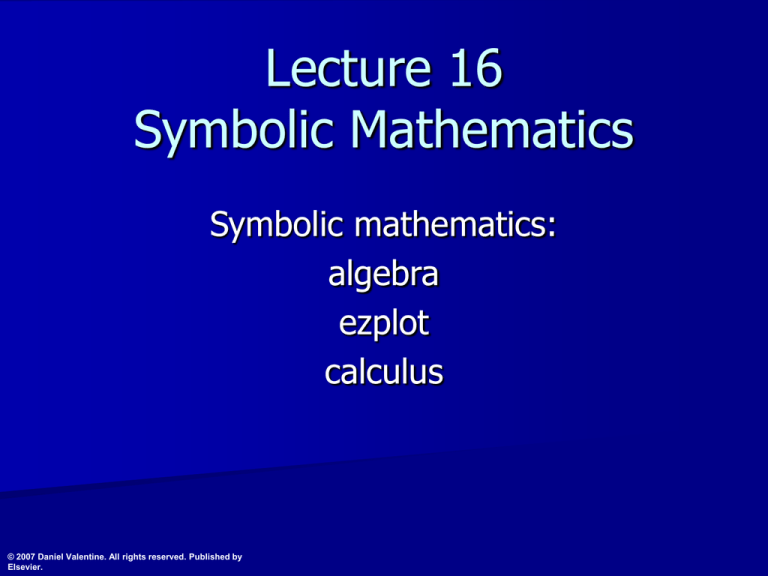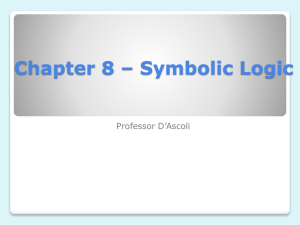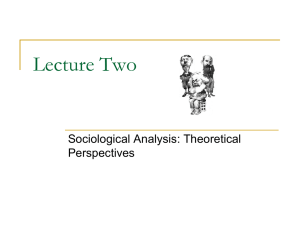
Lecture 16
Symbolic Mathematics
Symbolic mathematics:
algebra
ezplot
calculus
© 2007 Daniel Valentine. All rights reserved. Published by
Elsevier.
“Symbolic” toolbox allows you to:
Enter expressions in symbolic form with symbolic data
types.
Expand or simplify symbolic expressions.
Find symbolic roots, limits, minima, maxima, etc.
Differentiate and integrate symbolic functions.
Generate Taylor series of functions (among other tools).
Solve algebraic and differential equations symbolically.
Solve simultaneous equations (even some nonlinear).
Do variable precision arithmetic.
Create graphical representations of symbolic functions.
Creating Symbolic Variables
In order to use the symbolic toolbox, you
must create symbolic variables.
To create one symbolic variable, type:
x = sym('x');
You can also use the syms command:
syms x;
Creating Multiple Variables
To create several symbolic variables use
the syms command as follows:
syms K T P0;
This creates the symbolic variables K,
T, and P0; execute the command whos
to check that this is indeed the case.
Creating a symbolic expression with
symbolic variables
To create an expression using existing
symbolic variables, type:
P = P0*exp(K*T)
This creates a symbolic expression that
includes the exponential function. It could
represent the exponential growth of a
population.
Creating an expression with sym()
You can also create symbolic expressions
with the sym() command:
E = sym('m*c^2')
Symbolic equations
It is possible to write equations with the
symbolic toolbox. Type the following:
ideal_gas_law = sym('P*V = n*R*Temp')
This equation is the ideal gas law.
Manipulating symbolic expressions
numden()
expand()
factor()
collect()
simplify()
simple()
poly2sym()
numden()
The numden() command is used to
separate the numerator and denominator
of a quotient.
Use numden() on the following expression:
y=2*(x + 3)^2/(x^2 + 6*x + 9)
[numerator, denominator]=numden(y)
numerator=
2*(x + 3)^2
denominator=
(x^2 + 6*x + 9)
expand()
expand() is used to expand an expression
by expanding the products of factors in an
expression.
Expand the numerator of y:
expand(numerator)
expand(numerator
ans=
2*x^2 + 12*x + 18
factor()
The factor() command is used to factor an
expression into a product of terms.
Example: Factor the expression for the
denominator.
factor(denominator)
ans=
(x + 3)^2
simplify()
The simplify() command uses the Maple
simplification algorithm to simplify each
part of an expression.
Enter the expression:
b=sym('3*a - (a + 3)*(a - 3)^2');
simplify(b)
ans=
12*a - a^3 + 3*a^2 - 27
simple()
The simple() command executes many
techniques to simplify an expression; its
ans is the simplest expression.
simple(b)
ans =
3*a - (a + 3)*(a - 3)^2
Note: The simple() command displays the results of all
simplification methods; only the final result, i.e., the
answer (ans) is shown here.
poly2sym()
The poly2sym() function uses an array of
coefficients to create a polynomial:
a=[1,3,2];
b=poly2sym(a)
b=
x^2 + 3*x + 2
The function sym2poly() is the inverse of
poly2sym().
solve()
The solve() function sets an expression
equal to zero, then solves the equation
for its roots.
E1=x^2 - 9
solve(E1)
ans=
3
-3
Hands on
solve('a*x^2 + b*x + c')
ans =
1/2/a*( -b + (b^2 - 4*a*c)^(1/2))
1/2/a*( -b - (b^2 - 4*a*c)^(1/2))
Note: The expression is in single quotes; if
the symbolic variables in the expression
have not been defined previously, then the
single quotes are necessary.
Hands on
solve('a*x^2 + b*x + c', 'a')
ans =
-(b*x + c)/x^2
Note that this solves the expression for “a”.
Systems of equations
You can use solve() to find the solution of
a system of equations.
one=sym('3*x + 2*y – z = 10');
two=sym('-x + 3*y + 2*z = 5');
three=sym('x – y – z = -1');
[x,y,z]=solve(one,two,three)
x=
-2
y=
5
z=
-6
Note that the solve function produces symbolic output. You can
change the output to numerical values with the double() command.
Substitution with subs()
The subs() command allows you to
substitute a symbol with another symbol or
assign a number to a variable.
syms a b c x y;
quadratic = a*x^2 + b*x + c;
yquadratic = subs(quadratic,x,y)
yquadratic =
a*y^2 + b*y + c
Multiple substitutions
You can use the subs() command to do
multiple substitutions in one command.
This is done by grouping the variables and
their substitutes (other variables or
numerical values) in braces.
subs(symbolic_function, {substitutant}, {substitute})
subs(quadratic, {a,b,c,x}, {1,2,3,4})
ans =
27
Plotting symbolical functions
Plotting symbolic functions in MATLAB is
done with the ezplot() set of commands.
The syntax of ezplot() when y is a function
of x is:
ezplot(y)
x 2-2 x+3
y = sym('x^2 – 2*x + 3');
ezplot(y)
50
40
30
20
10
0
-6
-4
-2
0
x
2
4
6
Differentiation
MATLAB allows you to differentiate
symbolic functions with the diff() command.
The syntax of diff(), when f is a symbolic
function of the variable x and n is the order
of the derivative to be determined, is:
diff(f,'x',n)
diff(y,'x',1)
ans =
2*x-2
Try a second derivative. Your result
should be 2.
Integration
MATLAB allows you to integrate symbolic
functions with the int() command. Either
definite integrals, with assigned numeric or
symbolic bounds, or indefinite integrals (note
that when you compute indefinite integrals, the constant of
integration does not appear explicitly).
int(y,'x',a,b)
int(y,'x')
ans =
1/3*x^3-x^2+3*x
Try a definite integral for 1<x<2. Th
result should be 7/3.
Integration constant
If you want to display the integration
constant when applying the int() function,
you can do the following:
syms x y a
y = 2*x;
int(y,’a’,’x’)
ans =
x^2–a^2
Exercises
Use the symbolic toolbox to solve the
following system of equations:
x + 2y - z = 4
3x + 8y + 7z = 20
2x + 7y + 9z = 23
The velocity of a car is v = t^2 – 3t + 5. Find
the displacement for 1<t<5 and the acceleration
at t=1.5. Plot the equations for distance,
velocity, and acceleration on one graph.
Summary
Creating Symbolic Expressions
– sym(‘x’), syms x, expressions i.e. e=sym(‘m*c^2’)
Manipulation
– numden, expand, factor, collect, simplify, simple, poly2sym
Solutions
– solve, subs
Plotting
– ezplot
Differentiation
– diff(y, ‘x’, n)
Integration
– int(y, ‘x’, a, b)







